实用工程英语写作教程
- 格式:doc
- 大小:12.50 KB
- 文档页数:2
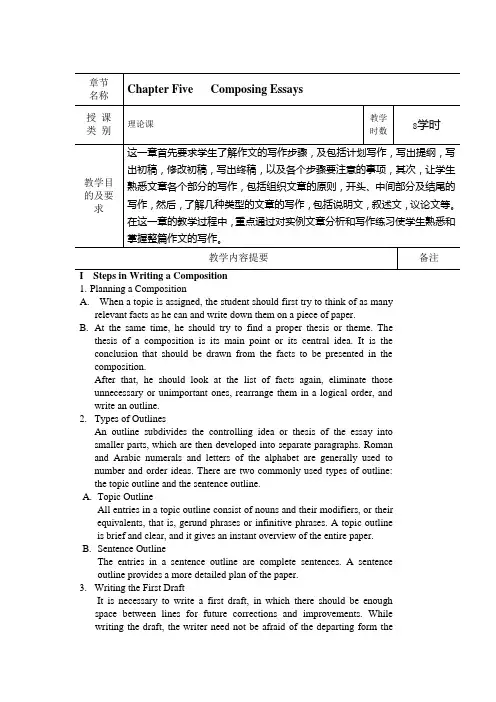
1.Planning a CompositionA. When a topic is assigned, the student should first try to think of as manyrelevant facts as he can and write down them on a piece of paper.B.At the same time, he should try to find a proper thesis or theme. Thethesis of a composition is its main point or its central idea. It is the conclusion that should be drawn from the facts to be presented in the composition.C.After that, he should look at the list of facts again, eliminate thoseunnecessary or unimportant ones, rearrange them in a logical order, and write an outline.2.Types of OutlinesAn outline subdivides the controlling idea or thesis of the essay into smaller parts, which are then developed into separate paragraphs. Roman and Arabic numerals and letters of the alphabet are generally used to number and order ideas. There are two commonly used types of outline: the topic outline and the sentence outline.A.Topic OutlineAll entries in a topic outline consist of nouns and their modifiers, or their equivalents, that is, gerund phrases or infinitive phrases. A topic outline is brief and clear, and it gives an instant overview of the entire paper.B.Sentence OutlineThe entries in a sentence outline are complete sentences. A sentenceoutline provides a more detailed plan of the paper.3.Writing the First DraftIt is necessary to write a first draft, in which there should be enough space between lines for future corrections and improvements. While writing the draft, the writer need not be afraid of the departing form theout line at one place or another. But he had better stop to revise his outline or work out a new one if he finds his original outline entirely impracticable.4.Revising the First DraftIf possible, a student should write the first draft one to two days before the time when he has to hand in the composition to the teacher. He will then have enough time for revising the draft, and be able to examine it more objectively.While revising a composition, the student should keep in mind that revision does not mean a simple correction of mistake in grammar, spelling, punctuation, and other mechanics.5.Making the Final CopyThe very last step in writing a composition, a step that should never be forgotten, is to check the final copy. In doing so the writer is likely to find that he has made careless mistakes in grammar and spelling, and he may also want to change a word here and there.II Organization1.Some PrinciplesA.Like a paragraph, a composition must have unity. A speaker may beallowed to digress from his main subject for a little while, but a writer is not given such freedom.B. A composition consists of several paragraphs, each of which has onecentral thought. They must be arranged in some kind of order, so that one paragraph leads naturally to another to form an organic whole.C.Proportion is as important to an essay as it is to a painting. Main facts orideas deserve full treatment; minor ones should be given less space. The essential part of an essay is the body or the middle part. To give this part about seven-or eight-tenths of the total space will be just right. The beginning and the end, though important, have to be short.2.The BeginningA.The beginning rouses the reader’s interest in and secures his attention tothe subject matter of the essay or provides necessary background information.B.The middle gives a clear and logical presentation of the facts and ideasthe writer intends to put forth.C.The end winds up the essay often with an emphatic and forcefulstatement to influence the reader’s final impression of the essay and shows the implication or consequences of the argument.Concluding paragraphs should be short, forceful, substantial, and thought-provoking, made up mainly of restatements or summaries of the points that have been discussed. No new ideas should be introduced in a concluding paragraph.Sometimes it is good to link the concluding paragraph to the introductory. If. For instance, a question is raised in the introductoryparagraph, an answer should be given in the concluding paragraph.III Types of Writing1.DescriptionA description essay is generally developed through sensory details, or theimpressions of one’s senses—sight, hearing, taste, smell, and touch. Not all details are useful. The writer should choose those that help to bring out the dominant characteristic or outstanding quality of the person or thing described, and leave out those irrelevant ones.A. Description of a personWhile describing a person, the writer should try to reveal the person’s character, thoughts, and feelings, which may be shown in what theperson does and says, or in how he behaves to others. And it is important to grasp the characteristic features that distinguish him from all other people.B. Description of a placePlaces may be described for their own sake, as in essays on visits to famous scenic places, but also for the purpose of revealing the personality and character of a person, or creating a feeling or mood. As in describinga person, in describing a place one should mainly write about the thingsthat make it different from other places.C. Description of an objectTo describe an object we have to depend on our senses, because we need to mention its size, shape, color, texture, taste, and smell. It is also necessary to tell how it is used if it is useful, and what part it plays in a person’s life if it is in some way related to him. But emphasis should be placed on only one aspect of the object, probably its most important characteristic.D. Description of a sceneA scene usually consists of three basic factors: the setting, the people,and the actions. It is also possible to describe the scene of some natural phenomenon.The writer should try to create a dominant impression when describing a scene. Before he begins to write, he must make up his mind as to what effect he wants the description to achieve. This will help him to decide which details to delete and which to include.2.NarrationTo narrate is to give an account of an event or a series of events. In itsbroadest sense, narrative writing includes stories, real or imaginary,biographies, histories, news items, and narrative poems.Narration often goes hand in hand with description. When planning anarrative, the writer should consider these five aspects: context, selectionof details, organization, point of view, and purpose.3.ExpositionExposition means expounding or explaining. Exposition mainly dealswith processes and relationships. We are writing a descriptive essaywhen we describe the appearance of an object; but we are writing an expository essay when we explain how it is made, how it is used, and how it may change. Things can be explained by illustration, process, classification and division, comparison and contrast, and analysis of their causes and effects or definition.The most important quality of exposition is clarity. To achieve this the writer should:A.Limit his subject or the scope of discussion, or it is impossible to explainmany things clearly in a short essay:B.Prepare enough material to help his explanation; the ordinary reader oftenfinds abstract discussions hard to follow if they are not illustrated by concrete examples;C.Present his facts and views in proper order.D.Pay attention to the accuracy and clarity of words and sentences; avoidornamental as well as ambiguous expressions.4.ArgumentationThe purpose of exposition is to inform; the purpose of argumentation, on the other hand, is to convince. While an expository paper makes know something and explains it to make the reader understand, an argumentative essay tries to make the reader agree with its point of view and support it. Argumentation is actually exposition with the additional purpose of convincing or persuading.If you wish to write a good argumentative essay, you should do your best to meet the following requirements:A.A debatable pointB.Sufficient evidenceC.Good logicD.Clear logicE.Good use of the other three types of writingF.An honest and friendly attitude。
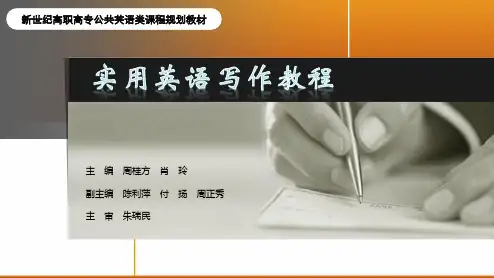
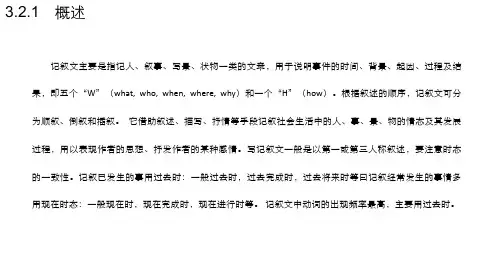

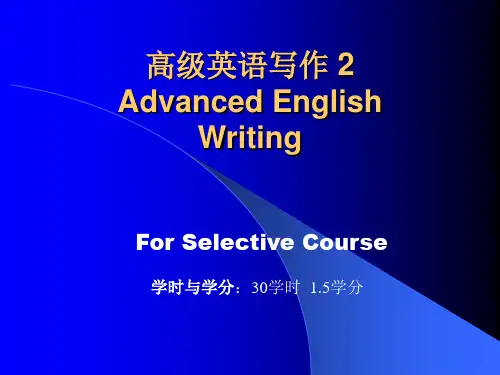
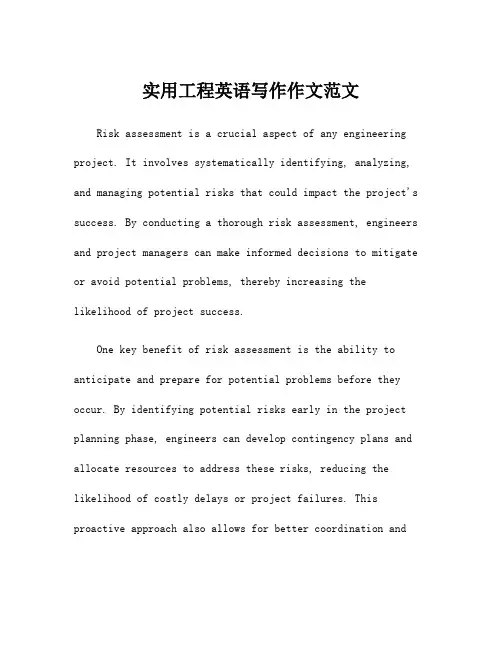
实用工程英语写作作文范文Risk assessment is a crucial aspect of any engineering project. It involves systematically identifying, analyzing, and managing potential risks that could impact the project's success. By conducting a thorough risk assessment, engineers and project managers can make informed decisions to mitigate or avoid potential problems, thereby increasing the likelihood of project success.One key benefit of risk assessment is the ability to anticipate and prepare for potential problems before they occur. By identifying potential risks early in the project planning phase, engineers can develop contingency plans and allocate resources to address these risks, reducing the likelihood of costly delays or project failures. This proactive approach also allows for better coordination andcommunication among project team members, as everyone is aware of potential risks and the steps to address them.Furthermore, risk assessment plays a critical role in ensuring the safety and reliability of engineering projects. By identifying potential hazards and risks, engineers can take proactive measures to design and implement safety protocols and quality control measures that minimize the likelihood of accidents or equipment failures. This not only protects the well-being of workers and the general public but also helps to safeguard the reputation of the engineeringfirm or organization responsible for the project.In addition, conducting a thorough risk assessment can also lead to cost savings and improved project performance. By addressing potential risks early on, engineers can avoid costly delays, rework, and budget overruns. This allows for more efficient use of resources and a more streamlinedproject timeline, ultimately leading to increasedprofitability and client satisfaction.In conclusion, risk assessment is an essential aspect of successful engineering projects. By systematically addressing potential risks, engineers and project managers can improve safety, financial performance, and overall project success. Embracing a proactive approach to risk assessment is crucial for the continued advancement of the engineering field and the successful completion of complex projects.。
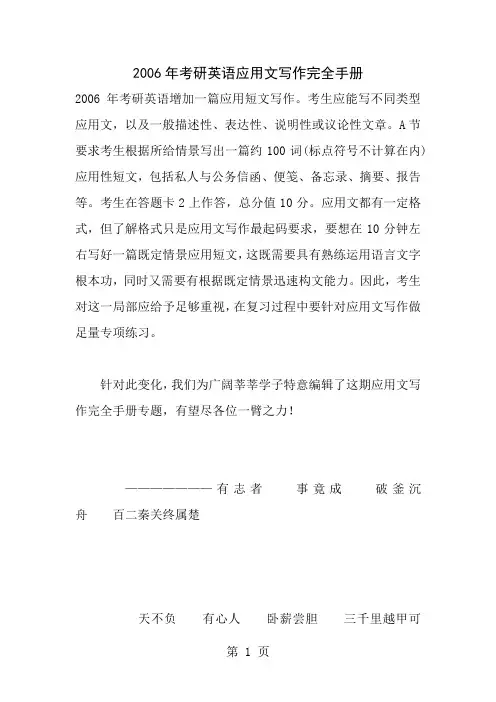
2006年考研英语应用文写作完全手册2006年考研英语增加一篇应用短文写作。
考生应能写不同类型应用文,以及一般描述性、表达性、说明性或议论性文章。
A节要求考生根据所给情景写出一篇约100词(标点符号不计算在内)应用性短文,包括私人与公务信函、便笺、备忘录、摘要、报告等。
考生在答题卡2上作答,总分值10分。
应用文都有一定格式,但了解格式只是应用文写作最起码要求,要想在10分钟左右写好一篇既定情景应用短文,这既需要具有熟练运用语言文字根本功,同时又需要有根据既定情景迅速构文能力。
因此,考生对这一局部应给予足够重视,在复习过程中要针对应用文写作做足量专项练习。
针对此变化,我们为广阔莘莘学子特意编辑了这期应用文写作完全手册专题,有望尽各位一臂之力!———————有志者事竟成破釜沉舟百二秦关终属楚天不负有心人卧薪尝胆三千里越甲可吞吴各种类型文章写作· 演讲与致辞· 证书· 证明· 合同与协议· 产品说明书· 天气预报· 食谱· 广告· 贺卡· 日记· 启事· 自我介绍· 海报· 通知· 简历--举例· 简历--概述· 摘要--常见句型· 摘要--概述· 备忘录--举例· 备忘录--概述· 便笺(便条)与短信--分类举例--回复友人问侯· 便笺(便条)与短信--分类举例--借物· 便笺(便条)与短信--分类举例--抱歉· 便笺(便条)与短信--分类举例--约请· 便笺(便条)与短信--分类举例--请假· 便笺(便条)与短信--概述· 私人与公务信函--分类举例--祝福信· 私人与公务信函--分类举例--请求信· 私人与公务信函--分类举例--求学信· 私人与公务信函--分类举例--感谢信· 私人与公务信函--分类举例--邀请信· 私人与公务信函--分类举例--求助信· 私人与公务信函--分类举例--推荐信· 私人与公务信函--分类举例--应聘信· 私人与公务信函--分类举例--私人介绍信· 私人与公务信函--常用句式· 私人与公务信函--概述演讲与致辞一篇好演讲稿,通常要有很精彩演讲词,以及很好文体特征与篇章构造,同时还得考虑所演讲对象。
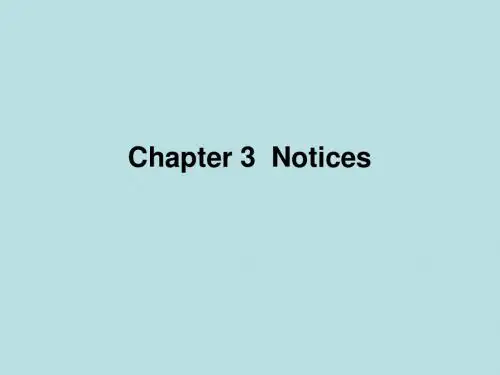
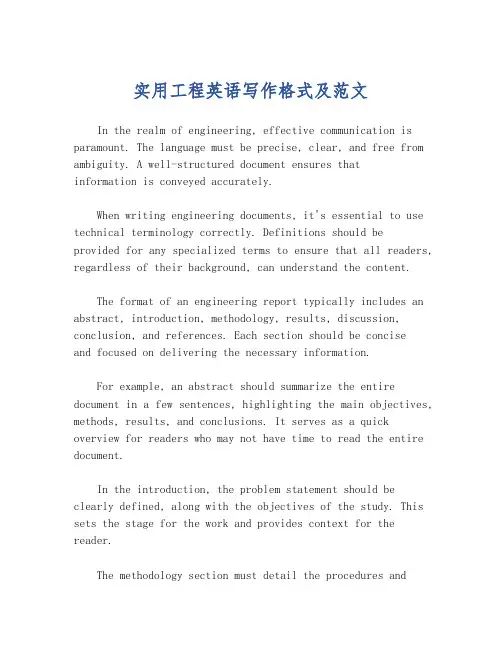
实用工程英语写作格式及范文In the realm of engineering, effective communication is paramount. The language must be precise, clear, and free from ambiguity. A well-structured document ensures thatinformation is conveyed accurately.When writing engineering documents, it's essential to use technical terminology correctly. Definitions should be provided for any specialized terms to ensure that all readers, regardless of their background, can understand the content.The format of an engineering report typically includes an abstract, introduction, methodology, results, discussion, conclusion, and references. Each section should be conciseand focused on delivering the necessary information.For example, an abstract should summarize the entire document in a few sentences, highlighting the main objectives, methods, results, and conclusions. It serves as a quick overview for readers who may not have time to read the entire document.In the introduction, the problem statement should beclearly defined, along with the objectives of the study. This sets the stage for the work and provides context for the reader.The methodology section must detail the procedures andprocesses used in the study. It should be thorough enoughthat another engineer could replicate the work.Results should be presented in a logical and organized manner, often using tables, graphs, and figures to enhance understanding. It's important to avoid interpretation at this stage and simply present the findings.The discussion section is where the results are analyzed, and their implications are explored. This is also the place to compare findings with existing literature and to address any limitations in the study.The conclusion should succinctly summarize the main findings and their significance. It may also include recommendations for future research or applications.Lastly, the references section should list all the sources cited in the document, following a consistent and recognized citation style.Remember, the goal of engineering writing is to communicate complex ideas in a manner that is accessible and understandable to a technical audience.。
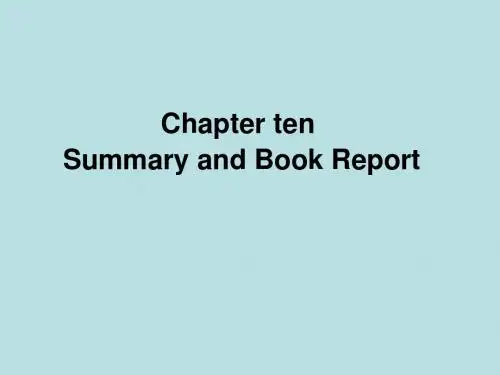

一、教学目标1. 培养学生英语写作的基本技能,包括句型结构、段落组织、文章结构等。
2. 提高学生的英语表达能力,使学生能够运用英语进行有效的沟通。
3. 培养学生的批判性思维和创造性思维,提高学生的逻辑推理能力。
4. 培养学生的英语写作兴趣,激发学生的学习积极性。
二、教学内容1. 英语写作基本技能:句型结构、段落组织、文章结构。
2. 英语写作常用词汇和短语。
3. 英语写作常用句型和表达方式。
4. 英语写作技巧:如何构思、如何组织材料、如何修改文章。
5. 英语写作实践:书信、报告、摘要、评论等。
三、教学方法1. 讲授法:讲解英语写作的基本知识和技巧。
2. 讨论法:引导学生进行小组讨论,分享写作心得和经验。
3. 案例分析法:分析优秀英语写作作品,提高学生的写作水平。
4. 实践法:让学生进行写作练习,及时反馈和指导。
四、教学步骤1. 导入新课- 通过提问或小组讨论,引导学生回顾已学过的英语写作知识。
- 提出本节课的学习目标,让学生明确学习方向。
2. 讲解英语写作基本技能- 讲解句型结构、段落组织、文章结构等基本知识。
- 举例说明,让学生理解并掌握相关技巧。
3. 介绍英语写作常用词汇和短语- 列举一些常用词汇和短语,并解释其用法。
- 让学生进行练习,巩固所学知识。
4. 分析英语写作常用句型和表达方式- 举例说明常用句型和表达方式,让学生了解其特点。
- 让学生进行练习,提高运用能力。
5. 讲解英语写作技巧- 讲解如何构思、如何组织材料、如何修改文章等技巧。
- 通过案例分析,让学生了解优秀写作作品的特点。
6. 实践环节- 让学生进行写作练习,如书信、报告、摘要、评论等。
- 教师巡回指导,及时反馈和纠正学生的错误。
7. 总结与反思- 让学生总结本节课所学内容,分享学习心得。
- 教师对本节课进行总结,提出改进建议。
五、教学评价1. 学生对英语写作知识的掌握程度。
2. 学生在写作练习中的表现,包括文章结构、语言表达、逻辑性等。
实用英语写作教程Dive into the world of effective communication with our practical English writing guide, a treasure trove of tips and tricks designed to elevate your writing skills to new heights. Whether you're a student aiming to ace your essays, a professional seeking to polish your business correspondence,or simply a language enthusiast looking to express yourself with clarity and flair, this tutorial is your go-to resource.Embark on a journey through the fundamentals, startingwith the art of crafting compelling sentences that capturethe reader's attention. Learn how to weave together verbs and nouns with finesse, avoiding common pitfalls like passivevoice and wordiness. Discover the power of the active voiceto make your writing more dynamic and engaging.As you progress, explore the nuances of paragraph construction, where coherence and flow are key. Master theart of topic sentences that set the stage for each paragraph, and practice the seamless transition between ideas to keepyour reader hooked.Venture into the realm of style and tone, understanding how to adapt your writing to suit different audiences and purposes. From the formal tone of academic writing to the conversational style of social media, learn to adjust your voice to resonate with your readers.Our guide doesn't stop there; it also delves into the intricacies of grammar, punctuation, and spelling, ensuring that your writing is not only impactful but also error-free. With exercises and examples to practice what you've learned, you'll be well-equipped to tackle any writing challenge that comes your way.So, are you ready to transform your writing from ordinary to extraordinary? Let's get started on this enlightening adventure that promises to unlock your full potential as a writer.。
实用工程英语写作作文范文下载温馨提示:该文档是我店铺精心编制而成,希望大家下载以后,能够帮助大家解决实际的问题。
文档下载后可定制随意修改,请根据实际需要进行相应的调整和使用,谢谢!并且,本店铺为大家提供各种各样类型的实用资料,如教育随笔、日记赏析、句子摘抄、古诗大全、经典美文、话题作文、工作总结、词语解析、文案摘录、其他资料等等,如想了解不同资料格式和写法,敬请关注!Download tips: This document is carefully compiled by theeditor. I hope that after you download them,they can help yousolve practical problems. The document can be customized andmodified after downloading,please adjust and use it according toactual needs, thank you!In addition, our shop provides you with various types ofpractical materials,such as educational essays, diaryappreciation,sentence excerpts,ancient poems,classic articles,topic composition,work summary,word parsing,copy excerpts,other materials and so on,want to know different data formats andwriting methods,please pay attention!Sure, I'd be happy to help you. Please provide the following information:1. The topic or theme of the practical engineering English writing composition.2. Any specific requirements or guidelines for the content, structure, or format of the composition.3. The level of language proficiency or target audience for the composition.4. Any additional instructions or details that you think might be relevant.With this information, I'll be able to better understand your needs and provide you with a more accurate and useful composition.。
实用工程英语写作课程反馈摘要:1.实用工程英语写作课程的概述2.课程反馈的重要性3.课程反馈的主要内容4.课程反馈对教学的促进作用5.结论正文:【实用工程英语写作课程的概述】实用工程英语写作课程是一门针对工程专业学生开设的英语课程,旨在帮助学生掌握在工程领域中进行有效沟通所需的英语写作技能。
课程内容包括撰写工程报告、信函、电子邮件等各种类型的实用文档。
通过这门课程的学习,学生可以提高自己在实际工程工作中的英语写作能力,为未来的职业生涯做好准备。
【课程反馈的重要性】课程反馈在教育过程中具有重要意义。
它有助于教师了解学生的学习状况,发现教学中存在的问题,并及时进行调整。
同时,课程反馈也是学生对教师教学质量的评价,可以帮助学生更好地了解自己的学习需求,提高学习效果。
【课程反馈的主要内容】在本次实用工程英语写作课程的反馈中,主要包括以下几个方面:1.课程内容:学生对课程所涵盖的英语写作技能表示认可,认为这些技能对实际工程工作具有很高的实用价值。
同时,学生也建议教师在课程中加入更多实际案例,以便更好地将理论知识应用到实际工作中。
2.教学方法:学生普遍认为教师采用案例分析、小组讨论等互动式教学方法有助于提高学习兴趣和学习效果。
但也有学生提出,教师在讲解知识点时过于详细,容易让人产生疲劳,建议教师在讲解时注意把握节奏。
3.作业与考核:学生对课程作业的设置表示满意,认为作业能够巩固所学知识。
但在考核方式上,有学生建议增加口试环节,以检验自己的英语口语表达能力。
4.学习资源:学生对课程提供的教材、参考书籍等学习资源表示满意,但有学生提出,希望教师能提供更多网络资源,以便在课后进行自主学习。
【课程反馈对教学的促进作用】根据学生的反馈,教师可以对课程进行以下调整:1.调整课程内容,加入更多实际案例,提高课程的实用性。
2.改进教学方法,注意把握讲解节奏,提高学生的学习兴趣和学习效果。
3.调整作业和考核方式,增加口试环节,全面检验学生的英语写作和口语表达能力。
实用工程英语写作教程
本教程旨在帮助工程师和技术人员提高英语写作能力,特别是在工程和科技领域中的写作。
本教程将涵盖以下主题:
第一章:工程英语写作概述
介绍工程英语写作的基本概念和原则,探讨工程英语写作的目的、受众、样式和格式。
第二章:工程英语写作的风格
讨论工程英语写作的风格,包括简明扼要、准确、清晰、直接和具体等特点,介绍如何运用这些特点来改进工程英语写作。
第三章:工程英语写作的语法和标点符号
分析工程英语写作的语法和标点符号,包括主谓一致、时态、被动语态、连接词等语法要点,以及逗号、句号、分号等标点符号的使用。
第四章:工程英语写作的单词和短语
介绍工程英语写作中常用的单词和短语,包括技术术语、动词短语、名词短语等,并提供使用这些单词和短语的样例。
第五章:工程英语写作中的句子结构
分析工程英语写作中的句子结构,包括简单句、复合句、并列句等形式,介绍如何运用这些句子结构来改进工程英语写作。
第六章:工程英语写作的结构和逻辑
探讨工程英语写作的结构和逻辑,包括段落结构、文章结构、论据和证据等要素,介绍如何运用这些要素来改进工程英语写作。
第七章:工程英语写作的实践
提供工程英语写作的实践指导,包括如何准备、撰写、编辑和校对工程英语文档,以及如何与读者交流等方面的实践技巧。
本教程将通过实例、练习、案例和评估来帮助学生提高工程英语写作技能,提供工程英语写作方面的实用建议和实践经验。